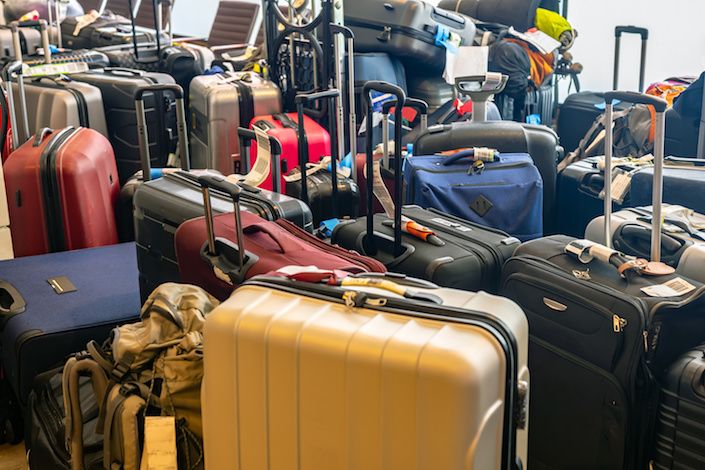Where travel agents earn, learn and save!
News / Canceled flights, lost luggage, staffing shortages, and other disruptions: Data shows hotels can be heroes amid the travel chaos
Data from 2 million bookings reveals surprising trends in guest booking patterns, preferences, and the rising demand for variable check-in and checkout times that can drive big revenue opportunities

At the height of the pandemic, if Stayflexi were to ask you to conjure up a view of your local airport, you might have envisioned an empty terminal, devoid of travelers’ lively chatter and the familiar, steady clicking of suitcases quickly approaching their departure gate. At the time, with domestic and international travel at a virtual standstill due to global lockdowns and mandates, airports were desolate places, waiting – seemingly with bated breath – for the revival of our industry. Would the hospitality industry be treated to an epic resurgence of interest, with guests from around the world exhibiting renewed and unsatiated appetites for travel? This was the question on everyone's mind as Stayflexi worked to put the pandemic behind us, their sights transfixed on a more optimistic future.
Now, with the aforementioned lockdowns lifted and global travel mandates eased, travel is – once again – back on the table for individuals, families, and professionals around the world. As Stayflexi had hoped, the demand for travel is alive and well, with many travelers frantically attempting to pack in two years worth of missed vacations, international adventures, events, and family reunions into their calendars. There is a catch, however. With post-pandemic staff shortages and infrastructure breakdowns at an all-time high, airports are seemingly breaking under the pressure of increased travel demand. The quiet, desolate image of airports that ruled our imagination during the pandemic's peak has been replaced with expectations of chaos, from delayed to canceled flights, long lines, unhappy travelers, and lost baggage. To this effect, according to the flight tracking website FlightAware, about 500 US flights had been canceled by midday Monday, August 8th. On Sunday, 950 flights were canceled. Last weekend, American Airlines reported a 4% flight cancellation rate, with 24% of its Saturday flights delayed. Similarly, United had 4% of its flights canceled and 23% delayed, followed by Delta with 2% canceled and 22% of its Saturday flights delayed.
When Stayflexi look north, they notice a similar trend, with Canadian passengers taking to social media to air out their grievances and warnings while camped out in busy terminals. On July 23rd, BBC News reported that Toronto Pearson International Airport – the busiest in Canada, with flights to 155 cities around the world – experienced the most delays of any airport globally for four days in a row that month. The article went on to explain how the pandemic caused an “unprecedented disruption to the industry” and, in its wake, demand has suddenly “whiplashed” back.
Perhaps CNN said it best – this is a great time to be an airline (US airlines just had one of the most lucrative quarters in history), but the worst time to be a passenger. The travel boom may be back, but the hospitality industry must now kick into second (and third, maybe fourth) gear to, once again, establish best practices that allow brands to appropriately prioritize the experience and goodwill of travelers. And if you ask Stayflexi, they should start with flexibility—specifically, flexible bookings.
Flexible Stays = Happier Guests
Traditionally, hotels do what they can to accommodate guest requests – the small ones, the big ones, and everything in between. Hospitality professionals are, after all, in the business of exceptional guest service. As such, most hoteliers are uniquely trained in the art of bending to meet (and hopefully exceed) the expectations of guests. However, when it comes to room reservations, the adage ‘where there’s a will, there’s a way’ has often been met with certain limitations. Left to manual processes, room allocation can be a complicated endeavor. Hotels usually require a great deal of staffing and backend shuffling to alter a guest’s reservation to extend, shorten, or otherwise modify their stay at the last minute.
In the past, if guests required late check-out, they would have had to speak with a front desk associate to ensure a late checkout was possible and add any applicable fees to their bill. More often than not, however, guests wouldn’t bother altering their reservations unless absolutely necessary. On the off-chance their flight was delayed or adjusted, they would simply hang out by the pool for the day or head into the surrounding town to bide their time. Of course, in today’s landscape, flight delays are no longer an “off-chance” experience; rather, they are becoming the industry norm, at least for the time being. Moreover, letting guests leave the property before they need to seems like a wasted revenue and service opportunity – because, quite simply, it is. Fortunately, this is where flexible booking comes into play.
With new, all-in-one property management technology, hotels can automate room allocation and seamlessly upsell unsold rooms and amenities in an entirely hands-off manner. No more waiting on the night audit. As you might have guessed, “hands-off” is a great feature at a time when hotels need all hands on deck to attend to the guest experience. This new technology empowers hotels by automatically recognizing bookings that are eligible for early check-ins, late check-outs, and flexible extensions. The platform simply showcases available options to guests, which ensures they are well taken care of while simultaneously boosting hotels’ minute unsold rooms and revenues. Delayed or canceled flight? No problem. Guests can easily extend or modify their stay – and make the most out of their additional time on property – using nothing more than a phone.
It’s High Time for Hotels to Rethink their Booking Strategy
Over the last year, the Stayflexi platform has collected data from approximately 2 million bookings. Of that data, Stayflexi discovered that 68% of bookings were a single-day stay, while 18% were 2-day stays, and 14% were 3-days and beyond. Segmenting further, Stayflexi noticed that, across business hotels, 62% of bookings were 1-day stays, 21% were 2-day stays, and 17% were 3-days and beyond. Finally, for leisure hotels, Stayflexi saw 42% of bookings represented by 1-day stays, 34% represented by 2-day stays, and 24% represented by 3-day and beyond stays.
Stayflexi also learned that 82% of the guests are either coming in early (4 hours before) or coming in late (4 hours late). Moreover, 52% of the bookings have a delta of 17 hours between check-in and check-out (less than one day), and 48% of the bookings have a delta of 32 hours between check-in and check-out (approximately 1.5 days). What exactly does this mean? First and foremost, the data indicates that the average length of stay (across both business and leisure travel) has shortened, perhaps due largely to modern travelers’ desire to experience different hotels and locations on a multi-day trip. Put simply, hotels can not expect to find success in the current landscape while still adhering to the traditional noon-to-noon model.
Even without the chaos currently unfolding at airports, guests crave unique experiences, convenience, and flexibility more than ever before – isn’t it time for hotels to deliver? A more flexible booking model not only acts as a competitive differentiator for hotels at a time when the industry is struggling to handle demand – it is long overdue as a simple means to reduce friction within the guest experience while driving revenue.
Stayflexi was created with a simple yet highly impactful goal: to develop cutting-edge technology that reimagines how rooms are managed, distributed, and sold. With Stayflexi's proprietary platform, hotels can instantly offer guests flexibility while driving additional revenues from unsold rooms and winning back direct guests. The future is flexible… and the future is finally here. What are you waiting for?







